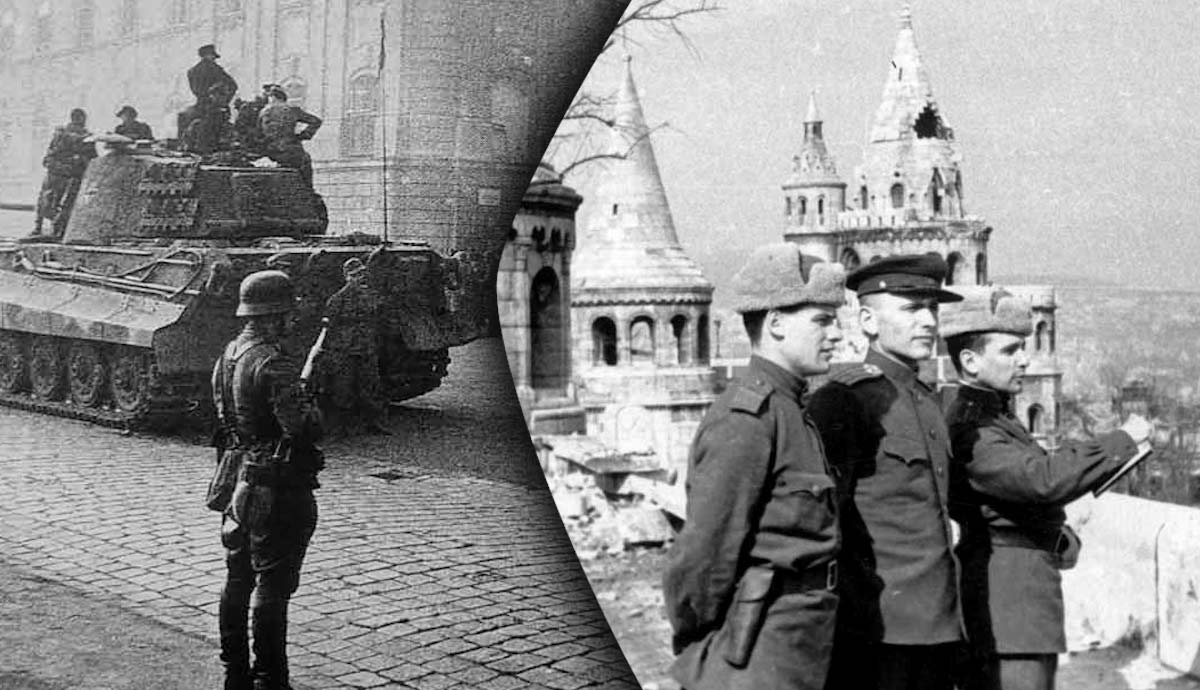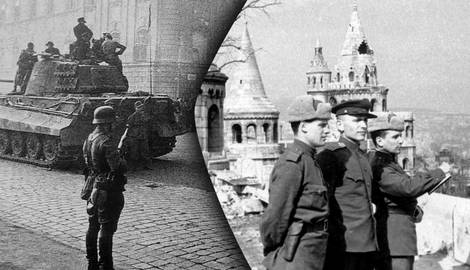
By the end of 1944, the situation for the Axis forces in Europe was critical. Soviet Armies had beaten a bloody swath across Axis territories in the east and were advancing further.
Romania was beaten and switched sides, joining the Soviets in their fight against the Axis forces. Germany’s last ally in the region was Hungary, and the Soviets sought this country’s capitulation as another step toward forcing the Germans to surrender.
Axis forces, however, fought on, resulting in the Siege of Budapest.
Desperate Times

During the Second World War, Germany relied heavily on Hungary for many resources. Of prime importance was bauxite, which was necessary for producing aluminum used in German aircraft. Hungary supplied 90 percent of German bauxite needs. Although the advancing Soviets concentrated the majority of their efforts to the north, driving directly towards Berlin, they realized that taking Hungary was still extremely important, not just for military reasons but for political ones. Stalin wanted Hungary in the Soviet sphere of influence once the war was finished.

As the war on the Eastern Front worsened each day for the Nazis, Germany struggled to keep Hungary as an ally. By the beginning of 1944, many Hungarians had already seen the writing on the wall. The Hungarian regent, Miklós Horthy, sought to remove Hungary from the war by negotiating a peace settlement with the Soviets. Upon hearing this, Hitler launched Operation Margarethe in March 1944. In doing so, German troops invaded and occupied Hungary. In October, the occupation was followed up by Operation Panzerfaust.
Infamous SS soldier Otto Skorzeny led a small armored column into Budapest and took Miklós Horthy captive, forcing him to abdicate. In his place, the Germans installed Ferenc Szálasi of the far-right National Socialist Arrow Cross Party as the head of the Hungarian government.
With the government under control, crack German divisions and Hungarian soldiers prepared to defend the city from the Soviet onslaught.
The Fortress

Hitler believed that if the Soviets could be delayed long enough, the tide of the war could be turned. He planned for Budapest to be the place where this would happen. He ordered all priority to be shifted to the defense of the city. A defensive line dubbed the “Attila Line” was created around the city, with emphasis placed on the highlands of Buda. Here, the Axis planned to inflict catastrophic damage on the Soviet forces.
Defending the city would be 41,000 Germans and 38,000 Hungarians. Included in the German army were two Waffen-SS divisions and the IX SS Mountain Corps from Croatia. Soviet and Romanian forces in the city would amount to 177,000 soldiers; however, the total number of those fighting was much higher as combat took place over a wide area that didn’t actually include the city of Budapest. This was due to a massive encirclement that took place on the flanks of the town.
The Encirclement

Under the overall command of Marshal Rodion Malinovsky, the 2nd Ukrainian Front began the offensive with over one million men split into two groups that maneuvered to isolate Budapest from the rest of Hungary and other Axis forces.
On November 7, the Soviets entered the city’s eastern suburbs, but they had no intention of pushing through straight away. Rugged defense blunted the Soviet attack, and a new plan had to be formulated.
In addition, the soldiers were tired, and logistics needed to be sorted out before the offensive could continue. With no immediate threat, the Soviets in the eastern suburbs took the opportunity for an operational pause, which lasted until December 19, when the offensive resumed. By this time, a sweeping pincer movement designed to encircle the entire city of Budapest had been completed. Fearing for his life, Ferenc Szálasi fled the city on December 9.
The Pincer movement began in November. The 6th Guard Tank Army and the 7th Guard Army struck north, taking the town of Hatvan and then pushing westwards to cross the Danube at Vác, directly north of Budapest. Directly to the south of Budapest, the 46th Army attempted to cross the Danube via Csepel Island.

Stalin was agitated by the slow progress, as taking Budapest would give him extra bargaining power at the upcoming Yalta Conference in early February. The drive to encircle the north of the city had to be reinforced with extra Soviet divisions, as the Germans put up an effective defense, slowing the Soviet advance to a crawl.
The southern arm fared even worse. The 46th crossed onto Csepel Island, a massive piece of land surrounded by the Danube, but struggled to advance further. The Axis forces were well reinforced, and Soviet progress was slow as they advanced north to secure the island. By the time a river crossing west was available, a Soviet army to the south, the 3rd Ukrainian Front, had pushed up through Yugoslavia and was poised to secure the western flank of Budapest.
At this time, the Soviet army was characterized by fierce rivalries between its commanders, and Malinovsky feared the 3rd Ukrainian Front would overtake his efforts and snag all the glory for encircling Budapest. It was in this framework of competitiveness that Malinovsky hastily ordered a river crossing. Attacking Axis positions without proper artillery preparation, the Soviet casualties were immense. Nevertheless, they pushed through, breaking the Axis lines of defense.

Progress was made in time, and the Soviet encirclement was completed on December 26 when the road between Budapest and Vienna was cut off, essentially trapping over 70,000 Axis soldiers and 800,000 civilians in the city.
As was his usual modus operandi in situations like this, Hitler refused to give an inch. He declared that Budapest was to be defended at all costs. Retreat or surrender was not an option, and those who did so were disobeying direct orders from the Führer. He declared Budapest a “fortress city,” and Waffen SS General Karl Pfeffer-Wildenbruch was put in charge of the Axis defenses.
On December 28, the Soviets addressed the Germans and Hungarians over loudspeakers, inviting them to surrender with promises of humane treatment. Two groups of emissaries, one from each Front, tried to treat with the Germans and Hungarians. They approached the enemy lines unarmed and bearing white flags. The emissaries from the 3rd Ukrainian Front spoke with Pfeffer-Wildenbruch, who refused the chance to surrender. When the Soviet delegation turned their backs to return to their lines, the Germans mowed the emissaries down. The group from the 2nd Ukrainian Front fared no better. They were fired upon before they even arrived at the Axis lines.
Fighting in Budapest

With the encirclement in place, the Soviets intensified their efforts within the city and began to press westwards. German and Hungarian forces gave resistance, rotating troops to keep fresh soldiers at the front, but the wide avenues of Pest meant the Soviets had a relatively easy task of advancing. Axis forces withdrew to new positions to the east to shorten the defensive line and prepared for attempts to break the encirclement.
On January 7, the Germans launched Operation Konrad, an attempt to retake the airfield to the west in order to provide relief for the city via the air. Spearheaded by the IV SS Panzer Corps, the Germans launched their last offensive of the Second World War.
The Soviets responded by reinforcing the area with four divisions, which halted the German offensive completely. Meanwhile, on the east bank of the river, Pest became impossible for the Germans to hold, and they eventually pulled back to the western side of the river to concentrate on defending Buda, destroying the five bridges that spanned the Danube after they had evacuated.

Vicious street fighting occurred as temperatures plummeted and Axis forces struggled to find food. They were forced to eat their horses. The city’s sewers also became a battleground. Raids and ambushes were conducted under the streets of Buda.
On January 17, the IV SS Panzer Corps made another attempt to break the encirclement but were met with little success. With the failure of this action, there was no hope of Axis forces being able to withstand the siege. Supplies and manpower were dwindling.
In the hilly terrain of Buda, the Axis forces were able to mount a more effective defense, but the Soviet attacks were relentless. The defenders were tired, disease-ridden, malnourished, and under intense artillery bombardment for weeks. Hungarian forces bolstered their numbers by conscripting civilians, many of them being secondary school students.
Hitler refused to allow any surrender, but many Hungarian troops defected and fought on the side of the Soviets. In the chaos, thousands of Axis soldiers attempted to coordinate an escape, but most were captured or killed. Only a few hundred managed to escape the encirclement. Pfeffer-Wildenbruch was captured during an escape attempt, and on February 13, the defenders finally surrendered.
Outcome

For the Soviets, the victory opened a path to Vienna, which fell two months later. The losses were grievous for the Germans, and the Waffen-SS became a severely reduced fighting force.
Casualties were high. From November 3 to around mid-February, the Axis lost around 140,000 men killed or wounded in the fighting in Budapest, while the Soviets lost between 100,000 and 160,000 killed or wounded.
The civilian population suffered terribly as well. Around 40,000 died in the siege, many from the result of the intense artillery barrages that leveled 80 percent of the city. Of these 40,000, about 17,000 were Jews, many of whom were rounded up and executed along the banks of the Danube by Hungarian nationalists. Another 40,000 civilians would later die in Soviet POW and labor camps. They were of hundreds of thousands taken by the Soviets to be used as slave labor.
For months after the battle, bloated corpses rose from the depths of the Danube and floated downstream.
During and after the battle, the remains of Budapest and its population were subjected to looting and raping at the hands of the victorious Soviet soldiers.

From a military perspective, taking Budapest was not a great victory for the Soviets. The casualty rate was extraordinarily high, and after the city fell, vital parts of the Transdanubia region still remained under German control for several months. It also delayed the advance of the 2nd and 3rd Ukrainian Fronts. At the same time that these armies were focused on Budapest, Soviet troops to the north had advanced from Warsaw almost all the way to Berlin.
This didn’t mean the Siege of Budapest was any victory for the Germans either. The casualty rate was far too high for an army that was quickly shrinking and struggling to defend its territory on multiple fronts.
Ultimately, the fall of Budapest was of little strategic importance to both sides when considering the movements happening on other parts of the European frontline. Soviets pushed to Berlin via a northern passage while the Western Allies pushed into Germany via France. Victory for the Allies in these areas was almost already assured.










